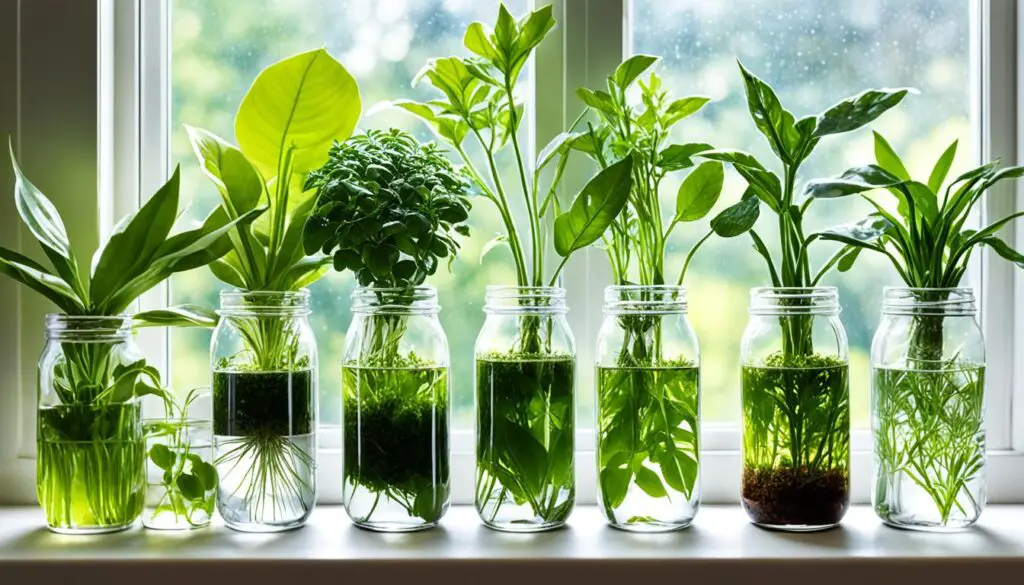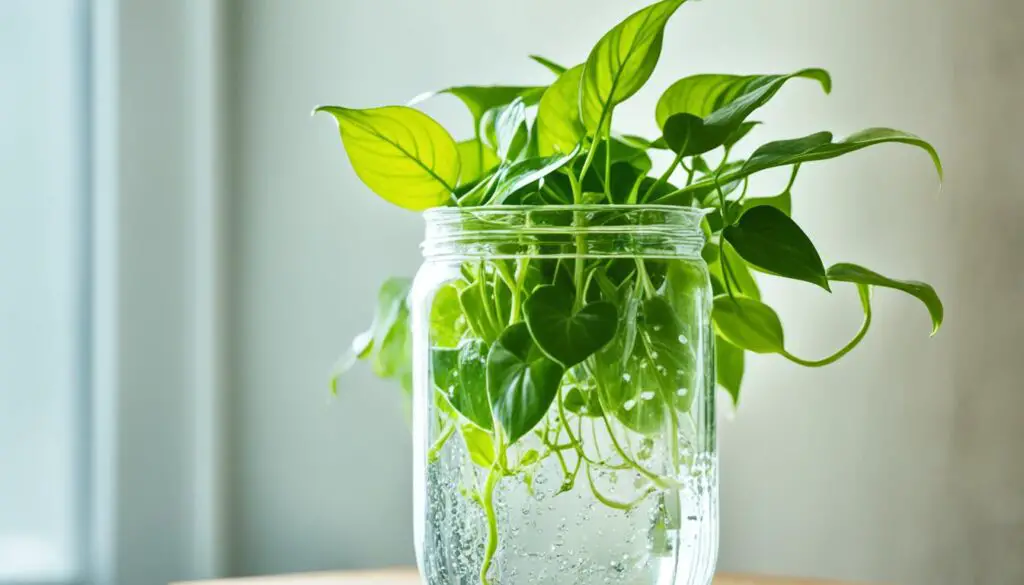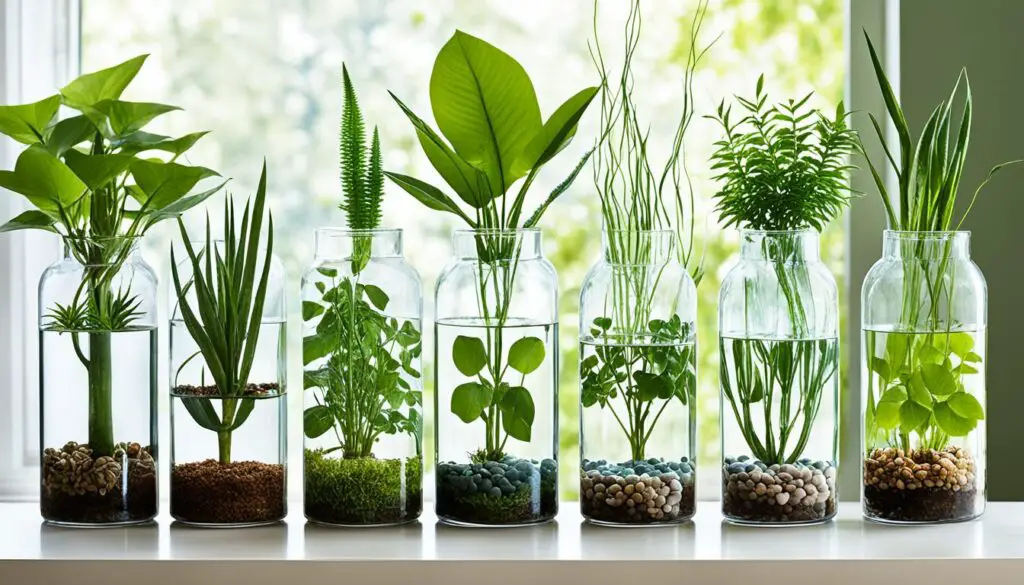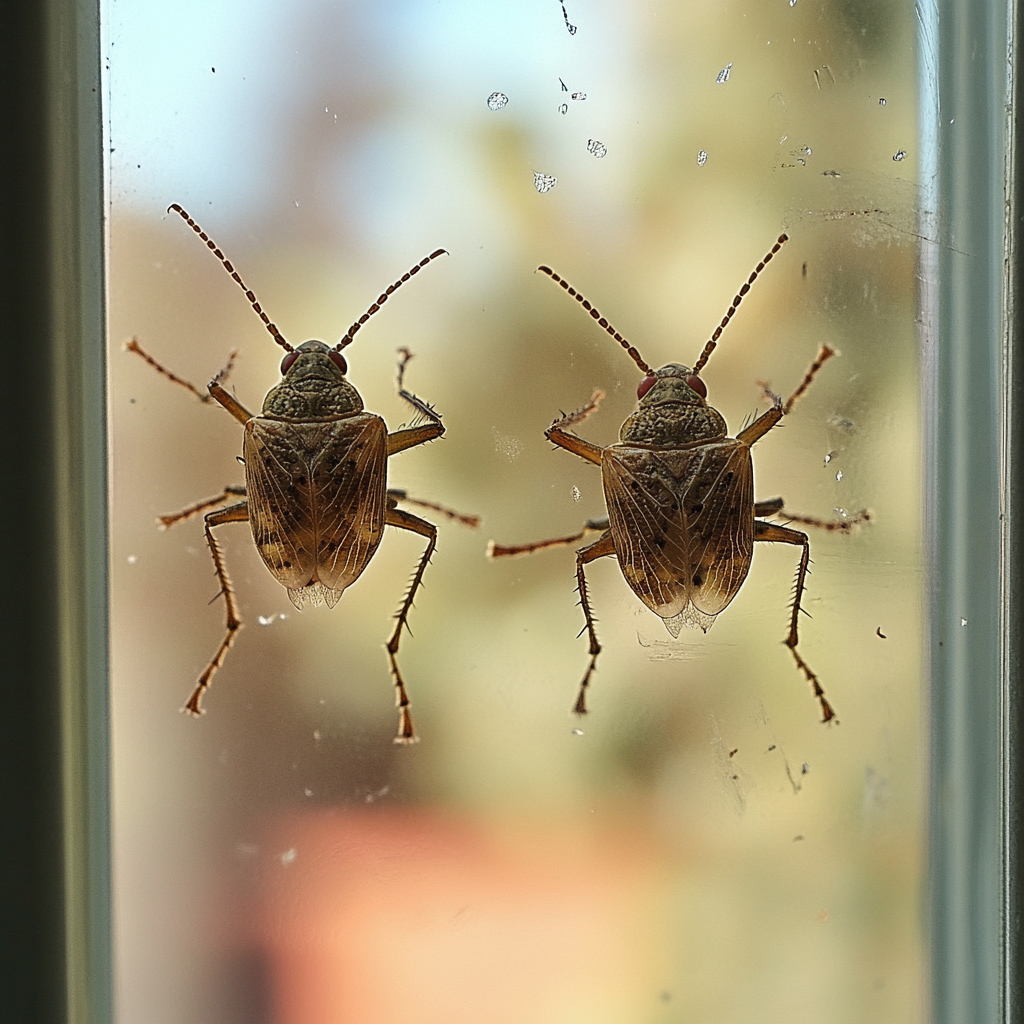Many popular houseplants, like Pothos and Philodendron, can grow in a container of water without soil.
By snipping off a cutting from one of your existing plants and popping it in a glass filled only with water and a touch of fertilizer, you can grow new and long-lasting plants at absolutely no cost.
Growing plants in water can be a low-maintenance, soil-free option for indoor gardening.
These water-grown plants are perfect for beginners and plant enthusiasts alike, offering a unique and visually interesting way to add greenery to your home.

Key Takeaways
- Many common houseplants can be propagated and grown in water without soil.
- Water-based gardening is a low-maintenance, cost-effective way to add greenery to your home.
- Water-grown plants offer a unique and eye-catching aesthetic for indoor spaces.
- Propagating plants in water is a great project for both novice and experienced gardeners.
- Pothos, Philodendrons, English Ivy, and other popular houseplants thrive in water-based environments.
Introduction to Growing Plants Without Soil
While soil is the traditional foundation for plant care, the world of water gardening and hydroponics offers a unique and innovative approach to cultivating soil-free plants.
By propagating cuttings in water, you can grow an array of indoor plants without the hassle of potting mixes and messy soil.
This method not only eliminates common issues associated with soil-based plants, such as pests and bacteria, but also requires less maintenance, as you don’t have to worry about watering schedules or repotting.
Benefits of Growing Plants in Water
Growing plants in water presents several advantages over traditional soil-based cultivation:
- Reduced maintenance: Water-grown plants require less frequent watering and no soil repotting, saving you time and effort.
- Cost-effective propagation: By taking cuttings and rooting them in water, you can create new plants at no additional cost.
- Cleaner environment: Water-based systems often eliminate the need for soil, reducing the risk of pests, fungi, and bacteria.
- Adaptability: Many indoor plants thrive in water-based environments, allowing you to grow a diverse array of species.
Preparing for Water Gardening
To get started with water gardening, you’ll need a few essential items:
- Watertight containers: Choose glass, ceramic, or plastic vessels that can hold water without leaking.
- Clean, filtered water: Use purified, chlorine-free water to provide the optimal environment for your plants.
- Understanding of light requirements: Different hydroponics and soil-free plants have varying needs when it comes to sunlight or artificial lighting.
With the right setup and a little bit of knowledge, you can unlock the joys of growing thriving indoor plants in water, without the hassle of soil-based gardening.
Pothos: The Cascading Vine
The Pothos (Epipremnum aureum) is a popular and low-maintenance houseplant that thrives in a water-only environment.
This vining plant is known for its cascading stems and lush, heart-shaped leaves that can add a touch of greenery to any indoor space.
Propagating Pothos in Water
Propagating Pothos is incredibly easy. All you need to do is snip off a 4-inch cutting just below a node, remove the lower leaves, and place the stem in a glass of water.
Within a few weeks, you’ll start to see new roots emerging, allowing the plant to continue growing in its water-based habitat.
Care and Maintenance
- Pothos are remarkably adaptable and can tolerate a wide range of lighting conditions, from bright, indirect light to lower-light areas.
- To keep your Pothos thriving, be sure to change the water every 1-2 weeks and add a few drops of liquid fertilizer occasionally.
- Regular pruning of any dead or damaged leaves will help maintain the plant’s lush, cascading appearance.

“The Pothos is a true workhorse among indoor plants, offering a low-maintenance way to bring nature indoors.”
Whether you’re a seasoned plant enthusiast or a beginner, the Pothos is an excellent choice for water-based gardening.
Its easy propagation and care requirements make it a versatile addition to any indoor plant collection.
Philodendrons: Lush and Leafy
Philodendrons, particularly the Philodendron hederaceum, are another fantastic choice for water-based growth.
Similar to the beloved Pothos, these vining plants root easily in water and can thrive long-term in a hydroponic setup. Philodendrons are low-maintenance, humidity-loving tropical plants that can tolerate a variety of lighting conditions, making them an excellent pick for indoor water propagation.
To propagate a Philodendron, simply take a cutting from a healthy vine, remove the lower leaves, and place the stem in water, just as you would with Pothos.
In no time, you’ll witness the emergence of lush, new roots, ready to be transplanted into a permanent water-based container or soil, if desired.
- Philodendrons are easy to grow in water and can thrive long-term in a hydroponic setup.
- They are low-maintenance, humidity-loving indoor plants that can tolerate a variety of lighting conditions.
- To propagate, take a cutting from a healthy Philodendron vine, remove the lower leaves, and place the stem in water.
“Philodendrons are the perfect choice for those looking to add a touch of lush, tropical flair to their indoor oasis.”

Whether you’re a seasoned plant enthusiast or just starting your indoor gardening journey, Philodendrons are a fantastic option to consider.
With their striking foliage and easy-to-maintain nature, these vining plants are sure to bring a touch of lush, tropical elegance to any space.
English Ivy: The Controlled Climber
While English Ivy (Hedera helix) is known for its aggressive, invasive nature outdoors, it can make a beautiful, controlled houseplant when grown in water.
When confined to a container, this vining plant‘s cascading vines and waxy foliage create a lovely accent in any indoor space.
Choosing the Right Variety
When selecting an English Ivy for your home, it’s important to choose a variety that is well-suited for indoor growth.
Look for cultivars with smaller leaves and stems, as they tend to be more manageable and less likely to outgrow their container.
Rooting and Caring for English Ivy
To propagate English Ivy in water, take cuttings just below a node, remove the lower leaves, and place the stems in water.
This trailing plant enjoys bright, indirect light and should be fertilized regularly during the growing season to maintain healthy growth.
“English Ivy is a versatile and rewarding indoor plant that can thrive in a water-based environment, adding a touch of natural beauty to any space.”
Houseplants You Can Grow In Water
When it comes to water gardening, the options go beyond the popular choices like Pothos, Philodendron, and English Ivy.
Many other houseplants can thrive when grown exclusively in water, creating a unique and low-maintenance indoor garden.
One such plant is the Lucky Bamboo, a member of the dracaena family that flourishes in water-based environments.
Spider Plants, known for their cascading foliage, are another excellent choice for hydroponics. Chinese Evergreen and Coleus also adapt well to soil-free cultivation, adding vibrant colors and textures to your water-based setup.
Even edible plants like herbs and vegetable scraps can be grown in water, allowing you to cultivate a self-sustaining indoor water gardening system. Begonias, with their showy blooms, are another versatile option that can be propagated and maintained in water-based systems.
These soil-free plants offer a range of benefits, from their low-maintenance nature to their ability to purify the air in your home.
By embracing water gardening and hydroponics, you can create a visually stunning and indoor plant collection that thrives without the need for traditional potting soil.
| Plant | Features | Care Tips |
|---|---|---|
| Lucky Bamboo | Durable, easy to grow, and adaptable to various lighting conditions | Change the water regularly, and provide indirect sunlight |
| Spider Plant | Produces offsets (baby plants) that can be rooted in water for easy propagation | Keep the water level consistent and provide bright, indirect light |
| Chinese Evergreen | Vibrant foliage in various colors, including shades of red, pink, and silver | Avoid direct sunlight and change the water weekly |
Whether you’re an experienced water gardening enthusiast or just starting to explore the world of soil-free plants, these versatile indoor plants offer a rewarding and low-maintenance way to bring nature into your living space.

“Growing plants in water is a fascinating and rewarding hobby that allows you to create a unique and visually striking indoor garden.”
Aglaonemas: Foliage Variety
Aglaonemas, also known as Chinese Evergreens, are a captivating choice for indoor gardeners seeking a splash of vibrant foliage.
These stunning plants boast a wide array of shapes, sizes, and leaf patterns, making them a versatile option for any living space.
Selecting and Propagating Aglaonemas
When choosing an Aglaonema, consider the specific variety that best suits your desired aesthetic and growing conditions.
From the classic green-and-silver variegated leaves to the bold, contrasting hues of the ‘Silver Bay’ cultivar, there’s an Aglaonema to complement any interior design.
Propagating Aglaonemas in water is a straightforward process. Simply take a cutting from a healthy shoot, ensuring it has around 5 developed leaves, and remove any foliage from the bottom portion of the stem.
Place the cutting in a container filled with water propagation and watch as the roots begin to emerge, transforming your indoor plants into a stunning foliage display.
| Aglaonema Variety | Leaf Pattern | Recommended Lighting |
|---|---|---|
| Silver Bay | Silvery-green with dark green veins | Bright, indirect light |
| Emerald Bay | Deep green with yellow-green variegation | Moderate to bright, indirect light |
| Siam Aurora | Pinkish-red new growth that matures to deep green | Bright, indirect light |

“Aglaonemas are a fantastic option for adding a touch of lush, foliage to any indoor space.
Their vibrant colors and unique patterns make them a true standout among Chinese Evergreen plants.”
Spiderwort (Tradescantia): Colorful Trailers
Known for their vibrant, striped foliage and trailing habit, Spiderworts (Tradescantia) are a versatile group of indoor plants that thrive when grown in water.
Also referred to as Inch Plants or Wandering Dudes, these colorful plants can add a stunning touch to any water garden or hydroponic setup.
Rooting and Caring for Spiderworts
Propagating Spiderworts in water is a simple process. Take cuttings just below a node, remove the lower leaves, and place the stems in a container filled with water.
Provide the trailing plants with bright, indirect light, and monitor the water level, replacing it as needed.
Within a few weeks, you’ll notice the development of healthy roots, signaling that your Tradescantia is ready to thrive in its new water-based environment.
Once rooted, Spiderworts require minimal care to maintain their vibrant appearance. Ensure the water level remains consistent, and consider adding a few drops of liquid fertilizer to the water every few weeks to provide the necessary nutrients.
With their easy-going nature and water propagation capabilities, these indoor plants are an excellent choice for those looking to explore the world of soil-free gardening.
Spider Plants: Nature’s Propagators
The Spider Plant (Chlorophytum comosum) is a beloved houseplant known for its easy-care nature and remarkable ability to propagate.
These trailing plants are true masters of self-propagation, making them a fantastic choice for water-based gardening.
Propagating Spider Plant Babies
One of the Spider Plant’s most endearing features is its natural tendency to produce baby plantlets, or “spiderettes,” on long, cascading stems.
These miniature versions of the parent plant can be snipped off and placed in water to develop a robust root system.
With a little patience and the right care, these baby plants will soon transform into thriving, independent Spider Plants.
Long-Term Care and Maintenance
- Once the Spider Plant babies have established a healthy root system, they can be easily maintained in water indefinitely.
- Regularly top up the container with fresh water to ensure the roots remain submerged, and provide a diluted liquid fertilizer every few weeks to keep the plants nourished.
- Spider Plants are remarkably resilient and adapt well to a water-based environment, making them an excellent choice for easy-care indoor plants and trailing plants.
With their cascading foliage and effortless propagation, Spider Plants (Chlorophytum comosum) are a must-have for any water gardening enthusiast.
These indoor plants not only thrive in water but also readily produce new plantlets, allowing you to create a lush, self-sustaining oasis in your home.
Dumbcane (Dieffenbachia): Bold and Beautiful
When it comes to striking foliage plants that thrive in water, the Dumbcane (Dieffenbachia) is a standout choice.
These large, impressive plants are closely related to Aglaonemas, and their thick stems and tolerance for a wide range of lighting conditions make them an excellent addition to any water garden.
To propagate a Dumbcane, simply take a 6-inch stem cutting from the parent plant and remove any leaves from the bottom portion before placing it in a container of water.
Dumbcanes are versatile indoor plants that can thrive when grown exclusively in water, making them a low-maintenance option for those new to water propagation.
| Feature | Dumbcane (Dieffenbachia) |
|---|---|
| Growth Habit | Large, upright foliage plants with thick stems |
| Lighting Requirements | Tolerates a wide range of lighting conditions, from bright indirect to low light |
| Propagation | Easy to propagate from 6-inch stem cuttings placed in water |
| Water Gardening | Thrives when grown exclusively in water, making it a low-maintenance indoor plant option |
Whether you’re a seasoned water gardener or just starting to explore the world of water propagation, the Dumbcane (Dieffenbachia) is a bold and beautiful addition to any collection of foliage plants.
Its striking appearance and easy-care nature make it a standout choice for any indoor or water-based gardening setup.
Tips for Successful Water Gardening
Creating a thriving indoor water garden requires a bit of care and attention, but the results can be truly rewarding.
To ensure your water-based plants thrive, choose containers that are watertight and opaque to prevent unsightly algae growth. Using clean, filtered water is also crucial, as this helps maintain the optimal pH and nutrient balance your plants need.
Monitoring the water level and replenishing it as needed is another key factor in successful water gardening.
Most plants will also benefit from a diluted liquid fertilizer every few weeks during the growing season, which provides essential nutrients to support lush growth and vibrant foliage.
By selecting plants well-suited for water-only growth, such as pothos, philodendrons, and spiderworts, and providing the right environment, you can cultivate a low-maintenance indoor garden that brings the beauty of nature right into your home.
With a little care and attention, your water-based plants will thrive and bring a touch of greenery to your living space.
FAQ
What are some popular houseplants that can be grown in water?
Some of the most popular houseplants that can thrive when grown exclusively in water include Pothos, Philodendron, English Ivy, Aglaonemas, Spiderworts, Spider Plants, and Dumbcanes.
What are the benefits of growing plants in water?
Growing plants in water can eliminate common issues associated with soil-based plants, such as mess, pests, and bacteria. It’s also a low-maintenance, soil-free option for indoor gardening that requires less watering and repotting.
How do I get started with water gardening?
To get started with water gardening, you’ll need watertight containers, clean filtered water, and an understanding of each plant’s light requirements. You’ll also want to provide the plants with a diluted liquid fertilizer every few weeks during the growing season.
How do I propagate plants in water?
To propagate plants in water, simply take a cutting from a healthy plant, remove the lower leaves, and place the stem in a container of water. The plants will root and grow new foliage from the nodes exposed to the water.
How do I care for water-grown plants long-term?
To ensure the long-term success of your water-based plants, monitor the water level and replace it as needed, provide the right amount of light, and supplement with a diluted liquid fertilizer every few weeks during the growing season.



